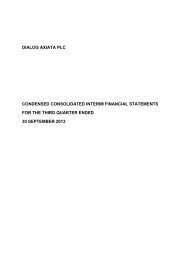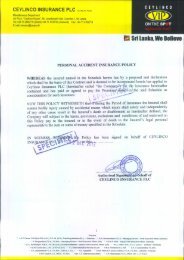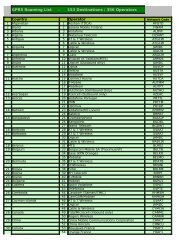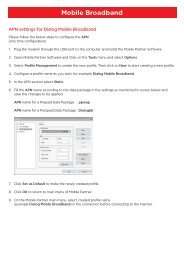Annual Report 2012 - Dialog
Annual Report 2012 - Dialog
Annual Report 2012 - Dialog
You also want an ePaper? Increase the reach of your titles
YUMPU automatically turns print PDFs into web optimized ePapers that Google loves.
64 l <strong>Dialog</strong> Axiata PLC l <strong>Annual</strong> <strong>Report</strong> <strong>2012</strong><br />
Notes to the Financial Statements<br />
2 Summary of significant accounting policies contd.<br />
2.8 Financial assets contd.<br />
(iii) AFS financial assets<br />
AFS financial assets are non-derivatives that are either designated in this category or not classified in any of the other<br />
categories. They are included in non-current assets unless the investment matures or management intends to dispose of it<br />
within twelve (12) months from the end of the reporting period.<br />
(iv) HTM financial assets<br />
HTM financial assets are non-derivative financial assets with fixed or determinable payments and fixed maturities that the<br />
Company’s and the Group’s management have the positive intention and ability to hold to maturity. If the Company and<br />
the Group were to sell other than an insignificant amount of HTM financial assets, the whole category would be tainted and<br />
reclassified as AFS. HTM financial assets are included in non-current assets, except for those with maturities less than twelve<br />
(12) months from the end of the reporting period, which are classified as current assets.<br />
(b) Recognition and initial measurement<br />
Regular purchases and sales of financial assets are recognised on the trade-date, the date on which the Company and the<br />
Group commit to purchase or sell the asset.<br />
Financial assets are initially recognised at fair value plus transaction costs for all financial assets not carried at FvTPL.<br />
Financial assets carried at FvTPL are initially recognised at fair value and transaction costs are expensed in the statement of<br />
comprehensive income.<br />
(c) Subsequent measurement - gains and losses<br />
AFS financial assets and financial assets at FvTPL are subsequently carried at fair value. Loans and receivables and HTM<br />
financial assets are subsequently carried at amortised cost using the effective interest method.<br />
Changes in the fair values of financial assets at FvTPL, including the effects of currency translation are recognised in the<br />
statement of comprehensive income in the period in which the changes arise.<br />
(d) Subsequent measurement - Impairment of financial assets<br />
(i) Assets carried at amortised cost<br />
The Company and the Group assess at the end of each reporting period whether there is objective evidence that a financial<br />
asset or group of financial assets is impaired. A financial asset or a group of financial assets is impaired and impairment<br />
losses are incurred only if there is objective evidence of impairment as a result of one or more events that occurred after the<br />
initial recognition of the asset (a ‘loss event’) and that loss event (or events) has an impact on the estimated future cash flows<br />
of the financial asset or group of financial assets that can be reliably estimated.<br />
Evidence of impairment may include indications that the debtors or a group of debtors is experiencing significant financial<br />
difficulty, default or delinquency in interest or principal payments, the probability that they will enter bankruptcy or other<br />
financial reorganisation, and where observable data indicate that there is a measurable decrease in the estimated future cash<br />
flows, such as changes in arrears or economic conditions that correlate with defaults.<br />
For loans and receivables category, the amount of the loss is measured as the difference between the asset’s carrying<br />
amount and the present value of estimated future cash flows (excluding future credit losses that have not been incurred)<br />
discounted at the financial asset’s original effective interest rate. The carrying amount of the asset is reduced and the amount<br />
of the loss is recognised in the statement of comprehensive income. If a loan or held-to-maturity investment has a variable<br />
interest rate, the discount rate for measuring any impairment loss is the current effective interest rate determined under the





![nrypq;Nfh ,d;#ud;;]; nfhk;gdp ypkplw - Dialog](https://img.yumpu.com/15429071/1/190x245/nrypqnfh-dud-nfhkgdp-ypkplw-dialog.jpg?quality=85)









